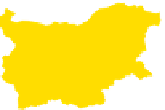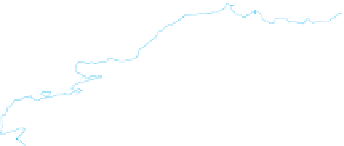Geography Reference
In-Depth Information
10
°
15
°
20
°
25
°
E
30
35
°
°
ETHNIC MOSAIC OF
EUROPE'S EASTERN FLANK
0
100
200
300 Kilometers
L
0
50
100
150 Miles
After Hoffman, 1953
LIT
RUSSIA
ND
VAKIA
Y
RO
M
30
°
35
°
Slavic
Non-Slavic
SERBIA
Poles
Macedonians
Serbs
Magyars
Albanians
Romanians
Czechs
Slovaks
Slovenes
Croats
Muslims
Bulgars
LGAR
Montenegrins
Figure 8.13
Ethnic Mosaic of Eastern Europe.
© Adapted (in part) with permission from George
Hoffma ed.,
Europe in the 1990s:
A Geographical
Analysis
, 6th rev. ed., p. 551.
Belarussians
Turks
R
KE
Ukrainians
Pomaks
Latvians
Lithuanians
MACEDONIA
GREECE
No group
over 50%
Russians
15
°
20
°
Longitude East of Greenwich
25
°
the assembly in Northern Ireland that was established in
1998, the parliament of Scotland has the right to levy a tax
of up to 3 pence per British pound.
Devolutionary pressures can create demands for
new states, such as the Czech Republic and Slovakia, or
for greater autonomy within a state, like Scotland in the
United Kingdom.
by the government in Rome high on the list of griev-
ances. Italy also faces serious devolutionary forces on
its mainland peninsula. One is rooted in regional dis-
parities between north and south. The Mezzogiorno
region lies to the south, below the Ancona Line (an
imaginary border extending from Rome to the Adriatic
coast at Ancona). The wealthier north stands in sharp
contrast to the poorer south. Despite the large subsi-
dies granted to the Mezzogiorno, the development gap
between the north, very much a part of the European
core, and the south, part of the European periphery, has
been widening. Some Italian politicians have exploited
widespread impatience with the situation by forming
organizations to promote northern interests, including
devolution. One of these organizations, the Northern
League, has raised the prospect of an independent state
called Padania in the northern part of Italy centered on
the Po River. After a surge of enthusiasm, the Padania
campaign faltered, but it pushed the Italian government
to focus more attention on regional inequalities within
the country.
Brazil provides another example of the interconnec-
tions between devolutionary movements and economics.
As in northern Italy, a separatist movement emerged in
the 1990s in a better-off region in the south that includes
the three southernmost States of Rio Grande do Sul,
Economic Devolutionary Forces
Devolutionary pressures often arise from a combination
of sources. In Catalonia, ethnocultural differences play a
signifi cant role, but Catalonians also cite economics; with
about 6 percent of Spain's territory and just 15 percent of
its population, Catalonia produces some 25 percent of all
Spanish exports by value and 40 percent of its industrial
exports (Fig. 8.15). Pro-independence groups in Cata-
lonia held a referendum in April 2011 seeking a vote for
independence. The vote failed, but devolutionary forces
continue to argue that Catalonia's economy pays more
into the Spanish government than it receives from the
state of Spain.
Economic forces play an even more prominent
role in Italy and France. In Italy, demands for auton-
omy for Sardinia are deeply rooted in the island's eco-
nomic circumstances, with accusations of neglect

































































































































































































































































































































































